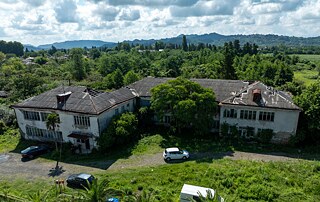Lanchkhuti
The physical mapping process for the municipality included both theoretical and practical aspects for two months. Experts, along with the educational component of the developed mapping methodology, mentored the municipality’s working group through each step of the process.
A detailed list of buildings and spaces was created. To collect information about these objects, research was conducted through inter-sectoral cooperation, fieldwork, and photofilming. The gathered data was then analyzed and recorded on a digital map, and the results were presented.
A detailed list of buildings and spaces was created. To collect information about these objects, research was conducted through inter-sectoral cooperation, fieldwork, and photofilming. The gathered data was then analyzed and recorded on a digital map, and the results were presented.
Physical Mapping Results
In the municipality of Lanchkhuti, 50% of the 34 mapped locations are administrative facilities, while 23% are culture and creative industry facilities. Educational and research institutions also industrial infrastructure account for 9% each and hospitality establishments represent 6% of the total.
The usage of listed properties follows as 41% in active use, 18% partially utilized, and 41% as nonfunctional.
The structural condition of the mapped buildings is 77% structurally stable, 20% lightly damaged, and 3% severely damaged.
74% of these properties are municipally owned, 9% are privately owned, and 14% are state-owned.
Notable buildings include the Lesa administrative building, the Chibati culture house, the Gvimbalauri administrative building, the ambulatory and sports space, Mamati administrative unit building, Former House of Culture of Mamati, Kvemo Aketi Culture House, Atsani administrative unit and Culture House, former collective farm building of Machkhvareti, Lanchkhuti former cheese-butter canteen, Administrative building of Chochkhati, House of Culture of Shromisubani, former hospital of Supsa, administrative building of Nigvziani.
The usage of listed properties follows as 41% in active use, 18% partially utilized, and 41% as nonfunctional.
The structural condition of the mapped buildings is 77% structurally stable, 20% lightly damaged, and 3% severely damaged.
74% of these properties are municipally owned, 9% are privately owned, and 14% are state-owned.
Notable buildings include the Lesa administrative building, the Chibati culture house, the Gvimbalauri administrative building, the ambulatory and sports space, Mamati administrative unit building, Former House of Culture of Mamati, Kvemo Aketi Culture House, Atsani administrative unit and Culture House, former collective farm building of Machkhvareti, Lanchkhuti former cheese-butter canteen, Administrative building of Chochkhati, House of Culture of Shromisubani, former hospital of Supsa, administrative building of Nigvziani.






